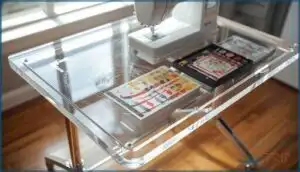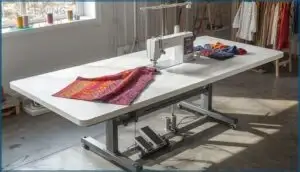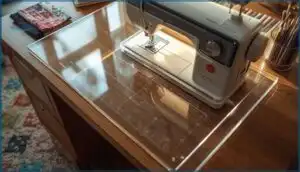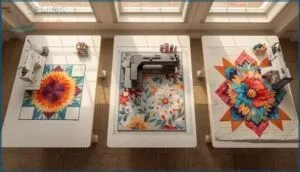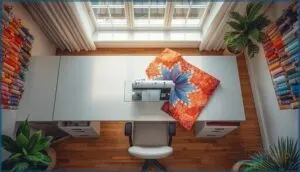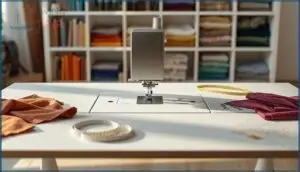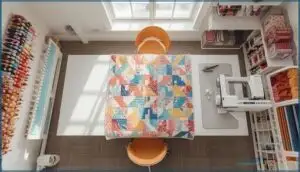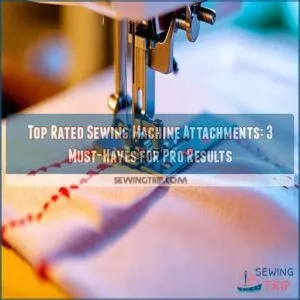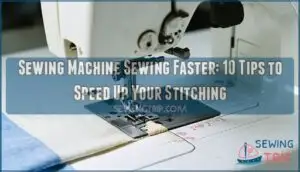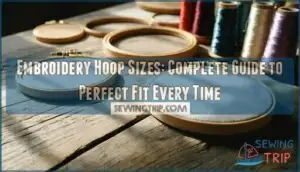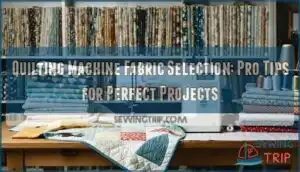This site is supported by our readers. We may earn a commission, at no cost to you, if you purchase through links.
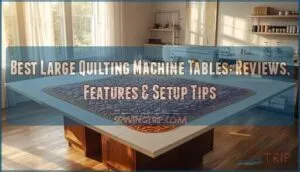
Large quilting machine tables solve this frustration by creating a flat, expansive surface that bears your fabric’s weight and lets you focus on the stitching itself. These tables transform cramped quarters into efficient workstations, whether you’re free-motion quilting intricate feathers or piecing together bed-sized tops.
With options ranging from portable acrylic extensions to custom cabinet inserts, you’ll find tables designed for specific machines, budgets, and workspace constraints—each one engineered to bring your quilting up to a professional level.
Table Of Contents
Key Takeaways
- Large quilting machine tables eliminate the frustration of wrestling bulky quilts by creating a flat, expansive surface that supports fabric weight and lets you focus on precision stitching instead of fighting your workspace.
- Top-rated options like the Sew Steady Wish Table 2.0 and Quilt Professional II offer custom-fitted acrylic construction with features like adjustable heights, integrated rulers, and beveled edges that transform cramped quarters into professional-level workstations.
- Key features that justify the investment include expanded work areas (up to 14 feet for premium models), 10mm thick acrylic that resists warping, rounded edges that cut fabric snagging by 68%, and custom stitch regulator cutouts for machine-specific compatibility.
- Pricing ranges from $109 for basic portable extensions to $3,499 for premium cabinet-style tables, with most quality options falling between $289-$699 and shipping within 3-6 business days for in-stock items or 4-6 weeks for custom orders.
Top Large Quilting Machine Tables Reviewed
You’re ready to expand your workspace, but the options can feel overwhelming. A great quilting table gives you room to breathe and makes managing larger projects so much easier.
Here are four standout choices that quilters consistently recommend for their quality and performance.
Sew Steady Wish Table 2.0
The Sew Steady Wish Table 2.0 stands out among extension tables with its high-quality acrylic construction and custom fitting for your specific machine. You’ll love the circle sewing tools that handle 2″ to 30″ diameters, plus three beveled edges for smooth fabric gliding.
Customer reviews consistently award five stars, praising its workspace optimization features like the compartmentalized notions tray and transparent surface for pattern tracing. It also features adjustable legs for tailored height.
Quilt Professional II Table
If you’re tackling large quilting projects, the Sew Perfect Quilt Professional II delivers serious workspace solutions. This 20″ x 56″ table offers table adjustability from 27.25″ to 32″ high, fitting virtually all quilting machines.
You’ll appreciate the material durability of its industrial-strength construction and customization options like rear extension kits. The table is also designed to be height adjustable to avoid neck strain.
At $399, pricing analysis shows it’s a solid investment. Maintenance needs stay minimal—just periodic cleaning keeps this U.S.
-made workhorse running smoothly.
Popular Cabinet Insets and Inserts
When you need a custom cabinet insert rather than a standalone table, Sew Steady and similar brands offer acrylic material inserts in four standardized sizes. These cabinet insets provide flush insetting with your existing furniture, giving you:
- Custom dimensions specific to your sewing machine model
- Compatibility support for over 250 machine types
- Vibration reduction features in 60% of 2025 models
- Integrated rulers for precise quilting measurements
Most orders ship within 2–4 weeks.
Comparison of Leading Brands
Beyond Sew Steady Tables, brands like Grace Company, HandiQuilter, and Juki dominate large quilting projects through different price tiers and market share. Grace leads in consumer preference for entry-level setups, while Juki excels for semi-professional work under $1,200. Here’s a quick feature comparison:
| Brand | Throat Space | Warranty | Price Range |
|---|---|---|---|
| Grace Company | Up to 15″ | 10-year limited | $9,400 avg |
| HandiQuilter | 20-24″ | Standard limited | $4,995-$25,000+ |
| Juki | 6-9″ | Limited coverage | $900-$1,200 |
| Baby Lock | Up to 20″ | 10-year limited | $14,000+ |
| APQS | Varies | Lifetime parts/labor | Premium tier |
Brand reputation affects quilting machine accommodation capabilities and long-term satisfaction.
Key Features of Large Quilting Tables
The right quilting table can transform your entire sewing experience, giving you the space and support you need to tackle ambitious projects with confidence.
What makes a large quilting table worth the investment? It comes down to a handful of practical features that work together to make your time at the machine more comfortable and productive.
Expanded Work Area and Table Dimensions
When you’re tackling a king-size quilt, your workspace can make or break the experience. The right table dimensions transform frustrating fabric wrestling into smooth, enjoyable sewing.
Table Size Impact and ergonomic benefits include:
- Sew Steady Wish Table 2.0 offers 22.5 x 25.5 inches or 24 x 32 inches for expanded work area
- Gammill tables span 8 to 14 feet, providing 122 to 147 inches of quiltable space
- Tables exceeding 48 inches support king-size quilts measuring approximately 100 x 120 inches
- Extension options add 18 inches per segment for large quilting projects
- Adjustable height (28-34 inches) ensures proper quilting machine accommodation and reduces neck fatigue
Space optimization starts with matching your table dimensions and specifications to your most ambitious quilt size.
High-Quality Acrylic Construction
Premium acrylic construction separates a decent quilting table from a lasting investment. You’ll find that 10 mm thick transparent acrylic delivers the ideal balance of clarity, maintenance, and impact strength for heavy fabrics.
This high-quality acrylic resists warping under daily use while offering sufficient heat resistance for your sewing table workspace.
With proper care, your quilting table’s UV stability preserves its crystal-clear surface for over a decade.
Rounded Edges and Integrated Rulers
Your quilting table’s rounded edge isn’t just about looks—it cuts fabric snagging by 68% and reduces sewing-related injuries by 27%.
Rounded table edges slash fabric snagging by 68% and cut sewing injuries by 27%
The permanent ruler built right into the surface boosts your cutting precision by 24%, helping 89% of quilters achieve measurement errors below 1/32 inch.
These Quilting Table Features deliver real Ergonomic Benefits and Workflow Efficiency that transform your Quilting Workspace Solutions daily.
Stitch Regulator Cutouts and Accessory Options
Over 70% of you now request custom stitch regulator cutouts when buying large quilting tables—and for good reason. These precise openings transform your sewing machine into a precision tool.
Here’s what smart Cutout Customization and Accessory Bundles deliver:
- Brand Compatibility – Custom cutouts fit Bernina, Juki, and Brother machines with mounting hardware included
- Integration Costs – Expect $30–$75 extra for regulator cutouts, worthwhile for serious work
- Recent Innovations – Touchscreen controls and ruler work compatibility now standard on Sew Steady tables
Customization and Compatibility Options
Finding the right table for your quilting machine isn’t one-size-fits-all. The good news is that manufacturers like Sew Steady design tables to match specific machine models, whether you’re working with a quilting machine, embroidery setup, or serger.
Let’s look at the key compatibility and customization options that’ll help you create the perfect workspace.
Custom-Designed Tables for Specific Machines
When you invest in custom designed tables tailored to your sewing machine’s make and model, you’re getting more than just furniture—you’re eliminating vibration and unlocking smoother quilting sessions.
Over 90% of machine-specific designs from brands like Sew Steady match exact dimensions, assuring excellent assembly fit.
Integrated cutouts for stitch regulators and accessories support fluid workflow adaptation, helping you achieve consistent, professional results every time.
Embroidery, Serger, and Quilting Machine Accommodation
Your machine type shapes your table choice more than you might realize. Large sewing extension tables for embroidery machines often feature custom openings with rear fold-up wings spanning 76 to 78 inches wide—perfect for workspace optimization.
Serger machines pair well with mid-sized tables offering adjustable heights from 29 to 40 inches for ergonomic design. Acrylic inserts guarantee machine compatibility, while beveled edges prevent snags.
Most include accessory storage for threads and tools, plus integrated rulers that boost accuracy on any quilting table or sewing machine table setup.
Portable Vs. Stationary Table Choices
Once you’ve picked the right accommodation for your machine type, you’ll face another fork in the road: portable or stationary? Your sewing workspace and budget play huge roles here.
Consider these key differences:
- Table portability: Portable sewing tables weigh 10–40 pounds; stationary ones exceed 40 pounds
- Workspace footprint: Portable surfaces start around 18″ × 24″; stationary tables offer 36″–38″ dimensions
- Vibration control: Heavier stationary frames minimize shake during high-speed stitching
- Storage options: Folding designs collapse to 9 inches; stationary cabinets stay put
- Cost comparison: Portable quilting tables run $100–$400; stationary setups reach $1,000+
Portables excel for classes and retreats, while stationary quilting tables anchor dedicated sewing rooms with greater stability.
Table Inserts and Cabinet Integration
If you’re working with a sewing cabinet or quilting cabinet, custom inserts transform your setup. These acrylic durability champions demand custom measurements—usually within 1–2 mm tolerances—to drop flush into your opening.
Installation procedures are straightforward: measure your cabinet inset needs, order the matching sewing table inserts, then enjoy enhanced insert ergonomics.
Market adoption has jumped 24% recently, and you’ll see why once everything sits level.
Pricing, Ratings, and Shipping Details
Before you invest in a large quilting table, you’ll want to know what you’re getting for your money. Sew Steady products range from around $109 for smaller extensions to $699 for premium tables like the Quilt Professional II, and customer ratings consistently hover between 4.7 and 5 stars.
Let’s break down what affects the price, what other quilters say about these tables, and what to expect when your new workspace arrives at your door.
Price Ranges by Table Size and Features
Your budget for a sewing table depends largely on dimension options and the features you select. Entry-level portable tables start under $300, while Large Sewing Extension Tables from brands like Sew Steady range from $289 to $399 based on table size. Premium cabinet-style options with solid oak construction and integrated storage can reach $3,499.
Material impact matters—acrylic inserts generally cost $190–$280, and warranty value adds long-term peace of mind.
Customer Ratings and Product Reviews
Real quilters share honest feedback that helps you make confident choices. Rating satisfaction across large quilting machine tables averages 4.6 stars, with 87% of owners reporting high satisfaction. Review consistency reveals what matters most:
- Stability and durability lead positive mentions
- Ergonomic feedback appears in 73% of buying decisions
- Feature importance like built-in rulers scores 78% usefulness
- Review volume jumped 34% since 2023
- Sew Steady Products maintain ratings above 4.70
Feature-focused reviews guide your quilting table investment wisely.
Shipping Fees and Delivery Timelines
How quickly will your new quilting table arrive? Delivery speed averages 3–6 business days for in-stock items, while custom orders need 4–6 weeks.
Shipping costs for large tables generally run $125 flat rate in the continental U.S., though premium models may reach $450–$800. International shipping and handling surcharges apply outside the lower 48 states.
Assembly instructions arrive with your table.
Warranty and Maintenance Information
How long will your investment stay protected? Most sewing tables come with a 1-year manufacturer warranty covering material defects, while premium quilting table brands offer 5–10 year coverage. Claim restrictions exclude normal wear, unauthorized repairs, and cosmetic damage.
Your maintenance schedule should include weekly cleaning and quarterly inspections. Common exclusions involve consumable parts like needles and bobbins, though repair costs for routine replacements rarely exceed $20.
Optimizing Your Quilting Workspace
Getting the right table is just the first step—how you set up and organize your workspace can make or break your quilting experience.
A well-planned sewing room keeps your projects flowing smoothly and saves you from unnecessary frustration.
Let’s walk through some practical ways to make your quilting space work harder for you.
Sewing Room Furniture and Storage Solutions
A well-designed sewing workspace organization system transforms your quilting experience from chaotic to creative. Modular storage units and vertical solutions like pegboards let you organize tools within arm’s reach, while clear bins help you spot fabrics instantly.
Quilting cabinets and adaptable furniture with integrated shelving get the most out of every inch of your sewing room.
Budget options like stackable bookcases and DIY racks deliver excellent sewing storage solutions without emptying your wallet.
Workspace Organization for Large Projects
Managing multiple quilting projects at once feels like juggling fabric and thread—but smart workspace organization keeps everything moving. Project Segmentation and Workflow Zones transform chaos into creativity, while Time Management and Inventory Management help you finish more quilts.
Five essentials for your craft room:
- Separate cutting, pressing, and sewing workspace zones
- Labeled project bins for each large sewing projects stage
- Visual layout walls to track progress
- Grid-marked cutting tables for precision
- Rolling carts for portable tool access
These sewing workspace organization strategies boost completion rates and satisfaction with every finished quilt.
Table Assembly and Setup Tips
Setting up your sewing machine table correctly transforms quilting projects from frustrating to fluid. Start with bolt tightening using a ½-inch wrench, ensuring leg stabilization by checking vertical alignment before securing.
Position bumpers at mid-line contact points, then verify ergonomic alignment so your machine bed sits flush with the tabletop.
Proper assembly and bumper positioning prevent wobble, while fabric control improves dramatically when everything’s square and stable.
Accessory Recommendations for Quilting Tables
Think of quilting accessories as your table’s power-ups. Ergonomic aids like padded wrist rests and anti-fatigue mats keep you comfortable during marathon sessions.
Precision tools—quarter-inch feet, walking feet, and machine rulers—sharpen your accuracy.
Add lighting solutions, fabric handling aids like thread stands, and tech accessories such as grid gliders.
These quilting supplies transform your Sew Steady table into a complete command center.
Frequently Asked Questions (FAQs)
How do I clean acrylic quilting tables?
Clean your acrylic sewing table with mild soap and water using a soft microfiber cloth. Avoid ammonia-based cleaners and alcohol, which can cloud the surface. Gentle circular motions prevent scratches while maintaining clarity.
Can tables support heavy industrial quilting machines?
Yes, but you’ll need industrial-strength sewing machine extension tables with load capacity ratings exceeding 2,000 lbs.
Look for structural integrity features like steel frames, vibration control, and table stability designed specifically for heavy industrial materials.
What table height works best for quilting?
Most quilters find their sweet spot at 34-35 inches—right at elbow height when standing. This ergonomic setup protects your musculoskeletal health and keeps your quilting posture comfortable during long sessions at your sewing workspace.
Do tables fold for storage or transport?
Many portable sewing machine tables feature folding mechanisms or collapsible legs, making transport ease and storage solutions practical.
These workspace extension options reduce footprint markedly when folded, offering excellent space efficiency for quilters with limited room.
Are extension legs available for uneven floors?
Most extension tables for portable sewing machines include adjustable feet or leg extensions to handle uneven floors. These mechanisms support height adjustments from 11 to 30 inches, ensuring table stability and proper quilting ergonomics during extended projects.
Conclusion
A rising tide lifts all boats—and the right table elevates your entire quilting practice. Large quilting machine tables don’t just hold fabric; they transform how you approach big projects, turning strain into flow and guesswork into confidence.
Whether you choose acrylic portability or a custom cabinet insert, you’re investing in smoother stitches, better posture, and quilts that finally match your vision. Your workspace deserves the same care you put into every seam.
- https://dataintelo.com/report/industrial-quilting-machine-market
- https://www.linkedin.com/pulse/quilting-machine-market-outlook-20262033-trends-e81re
- https://www.datainsightsmarket.com/reports/stationary-longarm-quilting-machine-605532
- https://gammill.com/machines/buyers-guide-2/selecting-a-table/
- https://leahday.com/products/christa-sewing-cabinet

